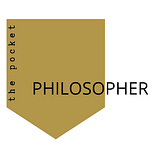Friends,
I hope you had a wonderful, restful weekend.
For the last week or so I’ve been doing a deep dive into a philosophical concept known as Game Theory, and I want to share some of it with you.
This idea is how researchers have mapped the way humans (and other animals) approach negotiation, competition, and strategy. Even more specifically, it’s the mathematical representation of the interaction among rational decision-makers in a competitive and/or cooperative environment.
People who use game theory make decisions based on probability, statistics, and data rapidly at scale—it’s like the AI mapping of instinct or intuition.
It’s a fascinating branch of philosophy and social science that has exciting implications in understanding biology/evolution, in predicting the next phase of technological advancement, in fundamentally shifting the basis of global financial markets, and most importantly, ushering the end to violent war.
We’ll get to all of that over the next two weeks, but today we need to set ourselves up by understanding some base-layer concepts upon which to build.
Philosophers have been grappling with the concepts of strategy and negotiation formally since the 16th century. It wasn’t until the 20th century, however, that the discipline really found momentum as early examples of scalable technology began making game theory increasingly relevant.
The purpose of Game Theory is to map and predict the behavior or rational agents in either a zero-sum competitive environment or the general behavior in cooperative ones. Any time rational agents must interact with each other to achieve an outcome, strategy has been introduced and Game Theory is there to help us make sense of the situation.
One of the most famous experiments surrounding this theory is the Prisoner’s Dilema.
This experiment was conducted by the RAND corporation in the 1950s. If you didn’t know, RAND is a massive think tank/research agency stocked with some of the brightest academics of our time employed by the US Department of Defense to understand some of the most complex and pressing issues the US perceive as a threat.
The Pentagon established a RAND outpost during the Vietnam War for example inside Vietnam with the sole purpose of extracting and communicating the fundamental motivations of various Vietnamese military factions.
Unfortunately, the knowledge gleaned isn’t always (if ever?) utilized effectively in real time. But that is beside the point.
If you consider the geopolitical environment of the 1950s, the burgeoning Cold War between the democratic west and communist east put the leaders of the world in what they felt was a zero-sum game. Both sides considered themselves and the other rational agents, and the goal was to develop a strategy consistent with winning a tense game of global stability in the shadow of Mutually Assured Destruction.
Remember this idea, we’ll need it again later on. It describes the state of affairs for the better part of the 20th century at the conclusion of WWII. It was a game, played largely between the US and USSR, in which the other side promised to completely annihilate the other if any long-range Nuclear Weapons were launched.
Because of the locations of nuclear stockpiles, it would take time for one to travel either from the USSR to the US or vice-versa. In that time, while the other side couldn’t protect themselves, they could launch their arsenal of weapons and ensure the destruction of the planet.
The game was so existentially frightening that a group of scientists led by Albert Einstein developed what was known as the Doomsday Clock, alerting the public how close we were to Mutually Assured Destruction. The closer we move to MAD, the closer to “Midnight” we creep. (The clock is still in use today, only it measures the stability of nations who might launch weapons, not the likelihood of Mutually Assured Destruction.)
And now we’re perfectly set up to take a dive into the Prisoner’s Dilemma.
But we’ve already said enough for today.
Check your email tomorrow as we peel back the layers of this study on our continued quest to understand Game Theory and implications it has on our present, and our future.
Excited to continue sharing my friends, until tomorrow,
Matt
PS, if you know someone who will find this series interesting, make sure to share so they can join us!
References:
https://en.wikipedia.org/wiki/Game_theory#Cooperative_/_non-cooperative
https://thebulletin.org/doomsday-clock/current-time/












